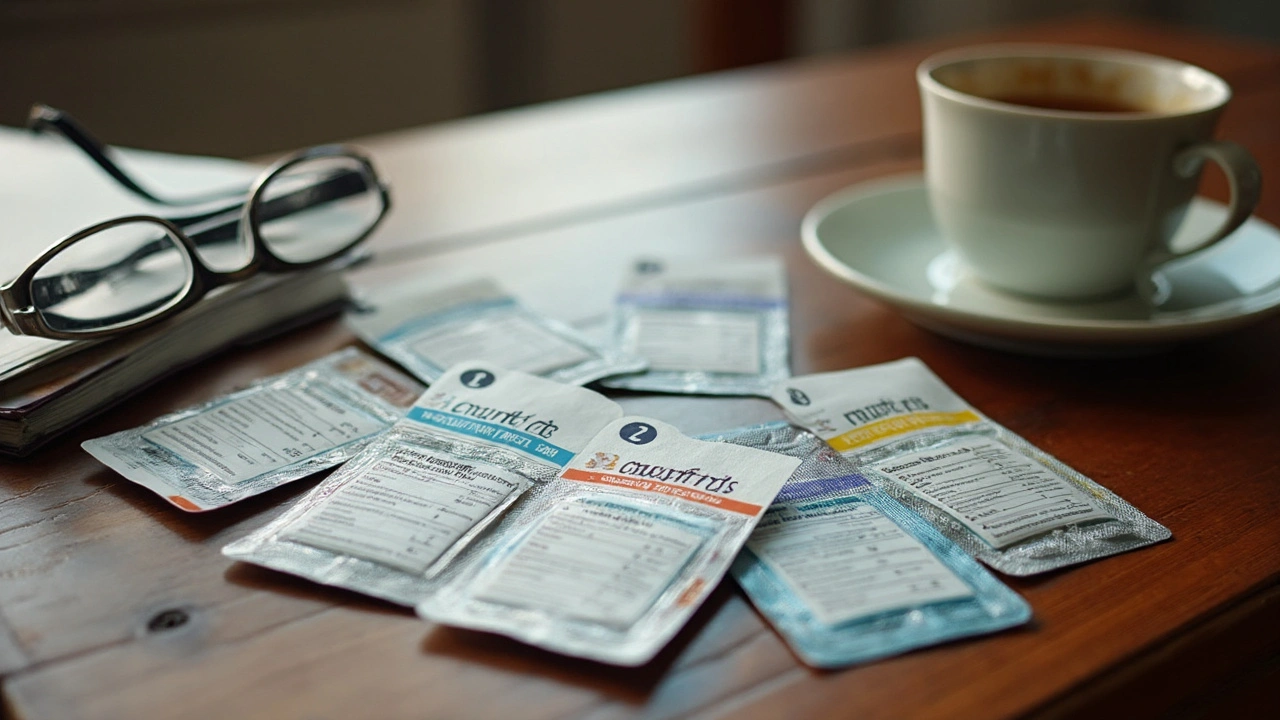Prednisone has been the go-to for everything from arthritis flare-ups to stubborn allergies, but let’s face it—the side effects can be a dealbreaker. Weight gain, mood swings, high blood sugar... the list goes on. If you’re tired of white-knuckling through those issues, it’s time to talk about other drugs that doctors are writing scripts for in 2025. And no, you’re not swapping one set of nasty side effects for another—in a lot of cases, these options are easier on your body (and sanity).
Ever wonder if there’s something that can rein in your symptoms without the jittery, bloated, can’t-sleep feeling Prednisone leaves behind? From long-standing immune meds to cutting-edge biologics, your choices now are not just more varied, but sometimes way less harsh. Here’s what you need to know about each alternative, so you can ask smarter questions at your next appointment and maybe find the treatment that finally fits your life.
- Methotrexate
- Hydroxychloroquine
- Azathioprine
- Mycophenolate Mofetil
- Leflunomide
- Cyclosporine
- Tacrolimus
- Biologic Therapies
- Summary Table: Prednisone vs. Alternatives
Methotrexate
If you’ve ever talked to anyone with autoimmune diseases like rheumatoid arthritis, there’s a good chance you’ve heard about methotrexate. It’s been used for ages, and for good reason—it actually works. Methotrexate isn’t a steroid like Prednisone. Instead, it slows down your immune system in a totally different way, blocking an enzyme the body uses to grow certain cells. This can help turn down the dial on inflammation without bombing your whole system like high-dose steroids do.
Most people take methotrexate just once a week. That’s a big perk for anyone who hates remembering to take pills every day. It comes as pills, liquid, or even tiny self-injection pens (kind of like insulin pens for diabetes). Usually, doctors start you on a low dose and check how you’re doing with regular bloodwork—mainly to keep an eye on your liver and blood cell counts. Some folks notice they feel a bit off the first day or two after their dose, but many say the trade-off is worth it for less joint pain and swelling overall.
Pros
- Well-studied; used for decades with loads of real-world tracking
- Only needs to be taken weekly
- Often delays or avoids need for long-term steroids
- Eases joint pain, swelling, and can even help with skin symptoms (like in psoriasis)
- Generic versions make it a cheaper option for many
Cons
- Must skip alcohol or keep it very limited—methotrexate and booze don’t mix well for your liver
- Common side effects: mild nausea, mouth sores, tiredness after the dose
- Requires regular lab monitoring (nobody loves extra blood tests)
- Not safe during pregnancy; women and men need to use reliable contraception
- Takes a few weeks (sometimes a couple of months) to feel full benefits
One practical tip: many doctors recommend adding folic acid (a simple, over-the-counter vitamin) to reduce those nagging side effects like mouth sores. If cost matters to you, methotrexate tends to be far more affordable than most new biosimilars or biologics, and insurance companies usually cover it without much fuss. It’s not a magic bullet, but for a lot of people looking for Prednisone alternatives, it’s a steady workhorse that can seriously level-up your symptom control.
Hydroxychloroquine
If you’ve spent time on autoimmune support forums, you’ve probably heard the name Hydroxychloroquine thrown around. Once used only for fighting off malaria, it’s now a staple for folks dealing with symptoms from lupus and rheumatoid arthritis. Doctors like it because it calms the immune system without blasting it into full shutdown—all while keeping your organs in better shape compared to some older drugs.
So, how does it actually work? Instead of shutting down your whole immune response like Prednisone, Hydroxychloroquine takes a more targeted approach. It interferes with certain pathways (think: Toll-like receptors and lysosomes) that fire up your immune system when it’s in overdrive. This means less joint pain, fewer skin problems, and often better energy.
Pros
- Helps protect your organs, especially your kidneys, from long-term lupus damage.
- Low risk of suppressing your immune system so much that you catch every cold going around.
- Usually doesn’t cause major weight gain or wild mood changes (a big deal if Prednisone has you on an emotional rollercoaster).
- Some studies show it even helps lower cholesterol and blood sugar, which is a bonus for people worried about heart disease or diabetes risks.
Cons
- Can cause retinal toxicity, which is a fancy way of saying your eyes can take a hit if you’re on it long-term.
- Requires regular eye checks—most doctors now recommend a yearly visit to the eye doctor to catch any trouble early.
- Doesn’t work fast. You might wait a few months before you feel the full benefits, so it’s not a quick fix for severe flares.
- Some people deal with mild stomach upset, especially at the start.
| Fact | Details |
|---|---|
| Usual Dose | 200–400 mg daily |
| Eye Check Interval | Every 12 months |
| FDA Approval for Lupus | Yes (since 1955), still widely recommended in 2025 |
If you can stick with the eye appointments, Hydroxychloroquine offers a steady, day-in-day-out approach. You might not feel supercharged results overnight, but over time, many notice steadier joints, less brain fog, and even fewer trips to urgent care. Always mention any changes in vision—blurry or strange spots should have you calling your doc.
Azathioprine
Azathioprine is a longtime alternative to Prednisone, especially for folks dealing with autoimmune conditions like lupus, rheumatoid arthritis, or some types of inflammatory bowel disease. If you want to get technical, it’s an immunosuppressant. Basically, it tells your immune system to calm down, but in a totally different way from steroids.
Doctors often turn to azathioprine when you need to keep inflammation in check for the long haul, since being on Prednisone for months or years can play havoc with your bones, blood sugar, and sleep. Azathioprine is taken as a daily pill, and you’ll usually start to feel its effects after a few weeks—so don’t expect overnight miracles. The upside: it can let you use much lower doses of steroids, or sometimes ditch them completely after a while.
“Azathioprine is well-established in clinical guidelines as a steroid-sparing agent, especially for conditions that otherwise require long-term corticosteroids.” – American College of Rheumatology Guidelines, 2024
Pros
- Lets you avoid or reduce Prednisone and its side effects
- Works for a wide range of autoimmune and inflammatory disorders
- Usually taken as an oral pill, which is easier for many than injections
- Has a long history, so doctors know a lot about managing its side effects
Cons
- Takes weeks to reach full effect (so not ideal for emergencies)
- Can lower white blood cell count, raising risk of infections
- Regular blood tests are required to keep tabs on your liver and blood cells
- May cause nausea, upset stomach, or—rarely—hair loss
| Azathioprine Check-ins | How Often |
|---|---|
| Blood tests (CBC, liver function) | Every 2-4 weeks at first, then less often |
| Doctor visits | Every 3-6 months |
If your doctor suggests azathioprine, don’t forget to ask about the blood test plan and how to spot signs of infection or unusual bleeding. People who do well on azathioprine often say it’s worth the tradeoff just to get off the steroid roller coaster. If you want a Prednisone alternative that’s well-known and widely used in 2025, this one’s got a solid track record.
Mycophenolate Mofetil
When people talk about Prednisone alternatives for autoimmune diseases and inflammation, mycophenolate mofetil (sometimes called CellCept) always pops up in the conversation. Doctors use it for conditions like lupus nephritis, autoimmune hepatitis, and even some forms of arthritis. This med works by cooling down an overactive immune system. It stops certain blood cells—those white blood cell warriors—from multiplying like crazy and attacking your body.
It started out as an anti-rejection drug for people who had organ transplants, but it’s got a second life in the world of immune system disorders. If you’re dealing with issues that keep cropping up even after Prednisone, mycophenolate might be worth a chat with your doctor.
Pros
- Less likely than Prednisone alternatives to cause weight gain, fluid retention, or mood swings.
- Can be safely combined with other drugs—doctors often stack it with hydroxychloroquine or a low-dose steroid to minimize each drug’s drawbacks.
- Especially useful for kidney involvement in lupus—studies show it helps prevent long-term damage in lupus nephritis (up to 65% success in achieving kidney remission).
- Doesn’t mess with your blood sugar levels like steroids can, which is great if you’re worried about diabetes.
Cons
- Suppresses the immune system, making you more likely to pick up infections (especially weird or hard-to-treat ones).
- Can cause stomach upset, diarrhea, or nausea—sometimes enough to switch meds entirely.
- Requires regular blood tests to keep tabs on your white cell count and make sure your liver is handling things okay.
- Not safe in pregnancy—definitely needs to be swapped out if you’re planning to have a baby.
Here’s a quick look at how often people need to stop mycophenolate due to side effects:
| Side Effect | Patients Affected (%) |
|---|---|
| Gastrointestinal upset | 15-25% |
| Infection risk increase | 10-15% |
| Need for drug discontinuation | 5-10% |
If you’re sick of the classic Prednisone alternatives rollercoaster, this med might be a game changer. Still, it’s not for everyone—so talk through your risk factors and what monitoring is involved before starting.

Leflunomide
Leflunomide is a heavy hitter for people with autoimmune stuff like rheumatoid arthritis and sometimes lupus. It works by blocking an enzyme your immune cells need to multiply, so it basically chills out an overactive immune response without hitting you with all the side effects you might get from Prednisone. Doctors started using leflunomide as a steroid alternative once they noticed how it could slow down joint damage in people dealing with chronic inflammation.
If you’re tired of the rollercoaster that comes with steroids, leflunomide might be worth a look. It’s usually taken as a daily pill, and you can use it alongside other drugs like methotrexate if your doctor thinks that makes sense. One big plus: it can actually help protect your joints for the long haul, not just mask pain short-term.
Pros
- Oral pill, no needles needed
- Slows down joint damage, not just symptoms
- Doesn’t cause weight gain or facial swelling like Prednisone
- Can be combined with other meds for better results
Cons
- Takes a few weeks to kick in—don’t expect overnight relief
- May upset your stomach, or give you diarrhea
- Liver tests are a must—leflunomide can be tough on your liver
- Some people lose a little hair while taking it
- Not safe if you’re pregnant or planning to be
Doctors usually run regular bloodwork to make sure your liver is keeping up. According to a recent 2024 registry, about 10% of patients will need to switch meds because of liver enzyme changes—so having a good backup plan with your doctor helps. And unlike some steroid replacements, the side effects are usually reversible if you stop the drug.
| Leflunomide Stat | Typical Value |
|---|---|
| Time to see full benefit | 4–6 weeks |
| Chance of stomach side effects | ~20% |
| Usual starting dose | 20 mg/day |
| Need for monthly liver tests | Yes |
Bottom line: Leflunomide isn’t a magic bullet, but for a lot of folks wanting out of the Prednisone cycle, it’s a solid conversation starter at your next rheumatologist visit.
Cyclosporine
Cyclosporine is an old player in the immune-suppression game, but it’s still a real option if you can’t use Prednisone alternatives that target inflammation. It’s usually used for autoimmune diseases like rheumatoid arthritis, some severe skin conditions, and after organ transplants, but more rheumatologists are looking at it for people who react badly to steroids. It works by dialing back your immune system so it stops attacking your own body.
Here’s a fun fact: Cyclosporine was the first big breakthrough med that made organ transplants possible in the 1980s. Before that, rejection was pretty much a sure thing. Beyond transplants, it proved handy for controlling out-of-control immune systems where other drugs just couldn’t cut it.
Pros
- Strong at reducing immune activity if standard anti-inflammatories don’t cut it
- Useful for both severe autoimmune diseases and transplant protection
- Can be fast-acting compared to other alternatives
- Available as a pill or liquid, and even sometimes as an eye drop for certain conditions
Cons
- Raises blood pressure—if you already have hypertension, you’ll need careful monitoring
- Can affect kidney function, so you’ll need regular blood tests
- Increases risk of infections due to immune suppression
- Possible side effects: gum swelling, tremors, excess hair growth
- You can’t take it with grapefruit juice—it ramps up side effects and levels in a bad way
Doctors will usually set up a schedule for regular blood work to keep an eye on your kidney numbers and Cyclosporine levels. If you’re on other meds, especially blood pressure drugs or anything for cholesterol, let your physician know—Cyclosporine can mess with them. It’s not a DIY med; precision and routine checks are non-negotiable.
| Feature | Cyclosporine |
|---|---|
| Route | Oral, liquid, topical (eye drop) |
| Common use | Autoimmune diseases, transplant rejection |
| Main concern | Kidney, blood pressure issues |
| Monitoring needed? | Yes, frequent labs |
If you’re looking for a Prednisone substitute that’s strong without all the classic steroid side effects, Cyclosporine could be the ticket—just get ready to stay on top of labs and check-ins.
Tacrolimus
Tacrolimus often pops up when steroids like Prednisone aren’t working or can’t be used. Originally made for organ transplant patients to prevent rejection, it’s now a solid backup option for autoimmune troubles and some tough skin conditions—including eczema and severe psoriasis. Think of it as an immune system tamer. It doesn’t crush your immune response the way steroids do; instead, it calms down the overreaction that causes all the pain and swelling.
Tacrolimus comes as both a pill (for systemic issues like lupus or rheumatoid arthritis) and a topical ointment (great for skin problems). It actually blocks certain white blood cells from going into attack mode, which means less inflammation and less tissue damage over time. Compared to Prednisone, people often report fewer mood changes and less trouble with weight gain.
Pros
- Useful when steroids stop working or can’t be used due to side effects
- Can be applied directly to the skin for specific issues
- Less likely to cause weight gain, mood swings, or bone loss
- Works for several autoimmune diseases and atopic conditions
Cons
- Can raise your risk for infections since it suppresses the immune system
- Oral form may cause kidney problems or raise blood pressure—labs need checking
- Long-term use has been linked to a higher cancer risk (mostly lymphoma)—it’s rare, but doctors keep an eye out
- Topical version may sting or burn, especially when you first put it on
A 2022 survey found that nearly 15% of adults prescribed tacrolimus for eczema noticed fewer flares after switching from steroids. Still, you’ll need regular checkups to monitor your kidney function and blood pressure if you’re on it long-term. Like with most Prednisone alternatives, it’s a tradeoff: fewer steroid problems but a fresh set of things to watch.
Biologic Therapies
If you’re over the side effects of steroids like Prednisone, biologic therapies are changing the game in 2025. These aren’t your usual pills—they’re lab-engineered proteins (usually antibodies) that target super-specific parts of your immune system, not just blasting away at everything like steroids do. You’ll see these used a lot for conditions like rheumatoid arthritis, lupus, IBD, and even some severe asthma cases. Common names? Think Humira, Enbrel, Remicade, Rituxan, and Cosentyx—each one has its own target and vibe.
Most biologics are given as injections or infusions, either in a clinic or sometimes (with a little bit of training) at home. The idea is to stop the immune system from going off the rails, but in a way that’s a lot more precise than older drugs.
Pros
- Targeted action means fewer "whole-body" problems (your bones, skin, and weight usually stay out of the crossfire).
- Work for people who strike out with regular Prednisone alternatives.
- Some new biologics work fast—weeks, not months—to control nasty flares.
- No steroid-related risks like blood sugar swings or moon face.
- Can actually slow progression of diseases, not just treat symptoms.
Cons
- Pricey. Even with insurance, copays or out-of-pocket costs can be painful.
- Increased infection risk (because you’re still chilling out your immune system).
- Some people get injection site reactions, like redness or swelling.
- You’ll probably need regular blood tests to watch for rare but serious side effects.
- Not every insurance plan is keen on covering these first—sometimes you have to fail cheaper meds first.
Just to give you a sense of why cost is a big conversation, here’s what a year of treatment might look like for popular biologics in 2025:
| Biologic Name | Approx. Annual Cost (USD) |
|---|---|
| Humira | $70,000 |
| Remicade | $90,000 |
| Enbrel | $80,000 |
| Cosentyx | $90,000 |
While the sticker shock is real, many patients find their quality of life jumps way up with these drugs. If you’re a frequent flyer at the doctor’s office or stuck in a never–ending chase for fewer side effects, biologics might deserve a spot on your "what’s next" list.

Summary Table: Prednisone vs. Alternatives
There’s no such thing as the “perfect” drug—every option comes with its own pros and cons. But if you want a quick look at how Prednisone alternatives stack up in 2025, this table will help you see the big picture. This way, you can match what matters most to you—maybe it’s avoiding immune suppression, or maybe you just want to skip all those classic steroid side effects.
| Medication | How it Works | Key Pros | Major Cons | Main Uses |
|---|---|---|---|---|
| Prednisone | Steroid—suppresses inflammation by altering immune response |
|
| Allergies, autoimmune flare-ups, severe asthma |
| Methotrexate | Antimetabolite—slows down immune cells |
|
| Rheumatoid arthritis, psoriasis, some cancers |
| Hydroxychloroquine | Antimalarial—blocks certain immune triggers |
|
| Lupus, rheumatoid arthritis |
| Azathioprine | Antimetabolite—suppresses immune cells |
|
| Transplant, IBD, lupus |
| Mycophenolate Mofetil | Blocks immune cell DNA |
|
| Lupus nephritis, transplant |
| Leflunomide | Stops immune cell growth |
|
| Rheumatoid arthritis |
| Cyclosporine | Shoots down specific immune T-cells |
|
| Transplants, severe psoriasis |
| Tacrolimus | Targets T-cell activation |
|
| Transplants, eczema (topical form) |
| Biologic Therapies | Block specific immune system signals |
|
| RA, IBD, psoriasis, others |
When thinking about making a switch from Prednisone or when your doctor brings up one of these Prednisone alternatives, the goals are similar: keep symptoms down and ditch the worst side effects. One big shift in 2025 is doctors getting better at mixing and matching—sometimes starting you on a fast-acting steroid for the short term, then swapping over to one of these longer-term options to help you avoid trouble. If you’re unsure what’s right for you, ask about blood test monitoring and which symptoms each drug is best at controlling. The choice is personal—it’s totally okay to put quality of life front and center.



 Medications
Medications





Tim Ferguson
July 18, 2025 AT 13:20Well, isn't this just the latest chapter in the never-ending saga of medical experimentation? Everyone's jumping on the bandwagon to find something new, something shiny, because apparently, Prednisone has become the villain in this narrative. But let's pause and ask, is it truly about better health, or is it just the latest trend to replace one discomfort with another?
Side effects are always a gamble, right? So what makes these alternatives so revolutionary? I’m skeptical. It’s like trading one puzzle piece for another without really looking at the bigger picture. The article promises practical facts, but where's the philosophical depth here? What about long-term impact beyond the surface?
Anyway, I’ll dig deeper. This might just be another rollercoaster ride masked as progress.
Anastasia Petryankina
July 18, 2025 AT 13:46Honestly, I skimmed this expecting some groundbreaking revelations. Instead, it reads like your average medical marketing brochure—"8 alternatives," "less headaches," yada yada. Like, we get it, fewer side effects are appealing, but can we talk about what these "alternatives" actually do to your body?
I'm tired of this coddling language. Keep it real, keep it raw. The moment you sugarcoat a drug’s risks, you lose me. Anyone else feel like medical info always tiptoes around the ugly truths? Throw me the cold hard facts or just spare me the fluff.
But sure, I’m here for the practical facts—someone please tell me which alternative actually lasts longer without gutting your immune system.
Ashley Helton
July 18, 2025 AT 13:56Ha, I'm with you on the sugarcoating bit, but hey, at least it's approachable for once. No one wants to read a medical textbook when they’re already stressed out dealing with side effects, right?
That said, I appreciate the effort to break down options in simple terms. It’s like having a friend who actually knows the science but can still talk to you without sounding like they swallowed a dictionary. Has anyone here tried some of these alternatives? I’m curious how the real-world experience stacks up against the glossy brochure.
Also, for those worried about jargon, this article's no-nonsense style kinda makes the subject a bit less intimidating. We all need more of that in healthcare info!
Brian Jones
July 18, 2025 AT 14:06Absolutely! It’s crucial to feel empowered before making health decisions. This article is refreshing because it offers a partnership, not a lecture.
We often forget that medications are tools, not magic bullets. Exploring alternatives means opening the door to personalized care—something every patient deserves.
Still, side effects are like shadows that follow us, twisting our choices. But awareness, as provided here, helps us navigate the darkness with more confidence. Kudos to the author for shedding light on this.
Carlise Pretorius
July 25, 2025 AT 20:40hey thanks for sharin this! its so refreshing to see somethin so clear n honest about meds these days especially with Prednisone since it can be such a pain with the side effects
the article sounds like it actually gives the lowdown without makin it all scary which is tough to find sometimes
im really keen to hear if anyone here has switched to any of those options n how they got on with em
sometimes switching meds is tricky so any real world feedback is gold
Johnson Elijah
July 31, 2025 AT 07:20Wow! What a timely article this is! Alternatives to prednisone? Awesome! 🌟 I love that the article cuts through the typical medical mumbo jumbo and gives people practical facts they can actually use when talking to their doctors. Communication is so key! 💬
Change is scary but necessary sometimes, and knowing about options means patients can be true partners in their care. This can seriously improve outcomes because people are engaged in their own health journeys.
Who else here is excited about these newer meds? Anyone already on one? Let's share some positive vibes! 💪😊
Roxanne Lemire
August 1, 2025 AT 00:13I appreciate the focus on practical facts in this article. Prednisone certainly has a notorious side effect profile, so knowing what alternatives exist is important.
However, I noticed a few typos that slightly distracted me while reading. Otherwise, the content was valuable and aligned well with current approaches in treating inflammation with less systemic impact.
I wonder if the article addresses cost differences as well? That can be a big deciding factor for many. Also, long term efficacy and safety data would be crucial to consider before making any switches.
Alex Mitchell
August 1, 2025 AT 08:33This is a great discussion happening here, and I want to add that feeling informed and supported is half the battle when managing chronic conditions.
Also, it’s good to remember that what works best can differ quite a bit from person to person. That’s why having multiple alternatives to Prednisone and a clear understanding of them helps patients and doctors customize treatment plans that feel right and are effective.
Sending good vibes to anyone navigating these choices! 💙🙂
Bridget Dunning
August 2, 2025 AT 15:06From a more formal standpoint, the emergence of these eight alternatives in 2025 represents a landmark advancement in corticosteroid therapy. It is imperative for clinicians to remain cognizant of the evolving pharmacopeia to adequately counsel patients. While the absence of dense medical terminology aids accessibility, I would argue that a balance must be struck to maintain clinical precision.
The article commendably emphasizes the importance of shared decision-making between patient and physician — a cornerstone of contemporary healthcare. Nevertheless, it would be prudent to include detailed pharmacodynamics and comparative efficacy data in supplementary materials for those seeking depth.
Gary Smith
August 4, 2025 AT 11:33Enough with the nonsense about "alternatives"—Prednisone has been a critical weapon against inflammation for too long to just toss it aside because of a few side effects. These newfangled drugs are nothing but gimmicks, repackaged for profit.
People need to stop chasing after shiny promises and focus on what actually works. Side effects are part of the deal when you fight serious illness. No pain, no gain!
Honestly, the medical industry is just trying to keep us dependent. It’s high time folks wake up to the truth instead of falling for every new drug they push down our throats.
Dominic Dale
August 17, 2025 AT 05:06Ha! You think this is just about medical progress? Wake up! The push for 'Prednisone alternatives' is all about Big Pharma's agenda to boost profits and keep patients hooked on their new patents. They’ve been suppressing safer, cheaper treatments for decades.
Did you notice how the article conveniently avoids mentioning any natural or holistic options? It’s always about the next synthetic pill, the next chemical concoction. That’s not healthcare, that’s manipulation.
We need to question who really benefits from these so-called 'alternatives.' Spoiler: it’s not the patients. Stay vigilant, folks.